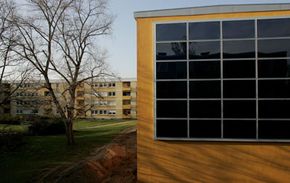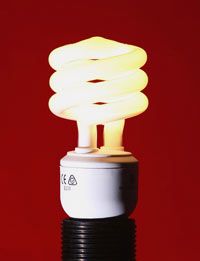
Maybe Kermit the Frog was wrong: It could be easy being green -- at least when it comes to buildings.
"Green building" and "sustainable development" are the hottest terms in construction right now, but what do they mean, exactly? According to the Environmental Protection Agency Web site, green building is "the practice of creating healthier and more resource-efficient models of construction, renovation, operation, maintenance and demolition" [source: EPA]. Proponents say that green building is not only environmentally friendly, but also healthier and more cost-efficient. So what is sustainable development? The United Nations Environment Program defines it as development that ensures our use of resources and the environment but doesn't restrict their use by future generations.
Advertisem*nt
For corporations, schools and hospitals, "green building" can entail anything from using waterless urinals to creating electricity. But homeowners who'd like to go green often don't have the big bucks that businesses do. There's a lot to consider, and the costs can make quite a difference in a home's budget. Homeowners can save cash by installing new energy-efficient light bulbs, but how "green" is it and how much "green" can it save? And who says what's green and what isn't?<
In this article, we'll give you some tips on making your home more environmentally friendly (maybe you can start by recycling your gray water), and we'll learn about current legislation and how other countries are going green.
Green Beyond the Home
There are plenty of green innovations beyond the home. Schools, businesses and hospitals are getting in on the green, which makes sense ecologically and economically. By improving air quality and temperature control and designing offices to increase natural light and open spaces, they get the bonus of happier, more productive workers. Corporate headquarters are also likely to go green because of the "environmental halo effect" -- when consumers choose a company because it's environmentally friendly.
Advertisem*nt
Contents
- Green Building Materials
- More Ways to Go Green
- LEED
Green Building Materials

If you want to go green but aren't quite ready to build a new home, here are some ways to make your existing home more environmentally friendly (check out the guidelines for new homes at How LEED Certification Works).
Recycled materials
Recycled building materials can be postindustrial (industrial byproducts) or postconsumer (recycled wood, metal, concrete). You can find a recycled version of pretty much any building material.
Advertisem*nt
- Recycled fly-ash from industrial furnaces makes concrete high-strength. Concrete can also be pulverized and remixed with cement to make new concrete.
- If you're building a deck, you can use "wood" made from recycled bottles.
- Steel is easily melted down and re-formed into new structural shapes.
- Sneaker soles can be shredded to make athletic surfaces.
- Even buildings that are imploded into a pile of rubble are recycled. Equipment, like large claws and shears, can crush and separate steel and concrete into separate piles for recycling.
Floors
Bamboo and cork floors are becoming popular choices because of their resemblance to traditional hardwood floors. The main problem with traditional hard woods -- like pine, maple and oak -- is that those forests take decades to regrow. Oak can take up to 120 years to fully mature [source: Treehugger]. But bamboo and cork are fast-growing: Bamboo (which is actually a grass) generally regenerates in about four to six years, and cork plants regrow in about nine years. Both get extra green points because their installation processes don't require toxic adhesives and produce less air-polluting fumes. They're also comparable in price to other wood floors, but there are more than a thousand varieties of bamboo and cork, so quality, color and price can vary widely. The Consumer Reports 2008 Buying Guide reported that bamboo and cork floors are susceptible to UV-ray discoloration, and some types require special cleaning products [source: Consumer Reports].
Other green flooring options include manufactured or engineered wood floors. These are actually veneers, made of layers of wood (often recycled) laminated together. They're typically cheaper and easier to install than traditional hardwood floors, but they also aren't as durable.
Tankless water heaters
Tankless water heaters produce heat only when a hot water tap is turned on, so they don't waste energy in "standby" mode. The water moves directly through the heater as it is needed -- it isn't stored in a tank. Tankless heaters can be electric or gas-powered (gas usually provides a higher water flow) and they come in various sizes. You can get one for the entire house or only for one appliance -- the dishwasher, for example. They are more expensive than conventional water heaters, but considering that heating water accounts for 15 percent of the average home's energy bills, you could recoup that cost sooner than later [source: Alliance to Save Energy].
Insulation
Consumer Reports says that heating and cooling costs comprise 45 percent of the average homeowner's utility bills [source: Consumer Reports]. According to the government's Energy Star site, extra insulation can cut those costs by 15 to 20 percent.
But installation of traditional fiberglass insulation requires a mask and gloves, which brings up a problem: If the fiberglass is so toxic that it can't be inhaled or touched, why are we sealing ourselves into the house with it? Recycled denim and shredded newsprint are quickly becoming the hottest green alternatives for insulation. Traditional fiberglass insulation has been refined over the years, but recycled materials don't contain as many chemicals (and they keep trash out of landfills). Recycled material is pricier, but it typically rates better than traditional fiberglass in insulation tests.
On the next page we'll find out about more possible green additions to your home.
Advertisem*nt
More Ways to Go Green

Solar panels
Going solar is definitely pricey, but you can expect to spend a lot less than just a few decades ago -- as much as 90 percent less, by some estimates (and some states offer tax incentives and rebates). Plus, many states now require utility companies to charge homeowners for only the energy they consume beyond their solar production. And some solar panels produce enough electricity to allow users to sell energy back to the utility company. The amount of time it takes to break even depends on a number of factors -- like your household's energy usage, the number of panels needed, the orientation of your home to the sun, and the amount of sun the panels get over time.
Recycled countertops
There are a myriad of choices for countertops for the modern kitchen -- from granite to quartz to ceramic tile to laminate -- but for those looking to build a green kitchen, recycled countertops offer an alternative to stripping stone from the earth. Countertops using recycled paper, glass and aluminum offer a variety of looks and price levels. Another alternative is a concrete countertop, which can be tinted and is popular for its durability.
Advertisem*nt
Compact fluorescent bulbs
Compact fluorescent bulbs are getting plenty of attention these days as the light bulb of the future. But in fact, they're not a new idea at all -- they're based on regular fluorescent bulbs, which cut energy costs during the 1970s oil crisis. Compact fluorescents are reshaped to fit most standard lamps, and some are even housed in traditional-looking bulb casings that are designed to counter the bluish tint that many people dislike about fluorescent lights. Compact fluorescents use a quarter of the electricity of incandescent bulbs and can last 10,000 hours (versus 800 to 1,000 for regular bulbs), which sounds great -- until you get to the hardware store and discover that they can cost $5 to $10 per bulb. Home Energy magazine advises trying out a few fluorescents in prominent places, like the kitchen. If you're OK with the lighting, you can convert slowly to avoid one big investment, or you can buy in bulk to lower the cost per bulb.
A Different Shade of Green
There's another school of thought in green building: building like nature. Some say that we should build like animals do, leaving the smallest possible environmental imprint. They cite Indian huts in Mexico that were carved out of mud and rock, making a case for building with biodegradable products that are found at the home site. "Natural building" is most popular in the western part of the United States, where land and material are more abundant. Common features of the natural home are stone foundations, sod roofs, discarded wood and straw-bale walls protected by adobe plaster -- producing a look that's much more "elves' cottage" than "space-age module."
Advertisem*nt
LEED

Green building is becoming increasingly popular in the United States, but there is no single, comprehensive federal green building program. LEED has become the default standard for green building, but there are other groups, like the Green Building Initiative and the aggressive Architecture 2030 initiative, that have their own green building practices. The federal government has offered tax breaks to those who comply with green building improvements, like a $300 credit for replacing an old water heater or air conditioner, and credit for 10 percent of the cost of insulation materials.
Individual states are also increasingly involved in developing green programs, but the programs vary. California leads much of the green building movement, with Gov. Arnold Schwarzenegger signing an executive order that says all new and renovated state facilities must have a silver LEED certification or higher.
Advertisem*nt
As of October 2007, 22 states and 75 towns and cities have adopted policies to require or encourage LEED's green building practices. New York City kicked off its green building movement with the reconstruction of the World Trade Center. The United Nations Department of Economic and Social Affairs' Division for Sustainable Development focuses on cooperation among its members to encourage green building techniques in developing countries.
Asian buildings have traditionally been designed and constructed with the land in mind. One of the best examples is the Miho Museum near Kyoto, Japan. Eighty percent of the structure, designed by Chinese architect I.M. Pei, is underground to preserve the natural landscape.
Green building is popular in Europe, too, especially in Germany and the Netherlands, and the European Union has a jump start on the United States in terms of regulations. In the mid-1990s, it adopted requirements for energy usage in any new construction on the continent. The European Commission instituted a voluntary green building program in 2005.
The United States is just now catching up with Europe and Japan, which have used innovations like tankless water heaters for years. But with current energy costs and the dip in the housing market, homeowners looking to save -- or make -- money on their homes are quickly catching on to going green.
For more information about green building, check out the links on the next page.
Advertisem*nt
Lots More Information
Related HowStuffWorks Articles
- How Fluorescent Lamps Work
- How Air Purifiers Work
- How House Construction Works
- How Prefab Houses Work
- How Water Heaters Work
More Great Links
Sources
- Alliance to Save Energy. http://www.ase.org
- Alter, Lloyd. "Bamboo Flooring -- is it Really Treehugger Green?" Treehugger.com, Sept. 12, 2005. http://www.treehugger.com/files/2005/09/bamboo_flooring.php
- American Wind Energy Association. www.awea.org
- Bongiorno, Lori. "How Do I Choose a Tankless Water Heater?" The Green Guide, March 11, 2004.
- "Consumer Reports 2008 Buying Guide." Consumers Union: Yonkers, NY.
- Earthcraft House (insulation grading): http://www.earthcrafthouse.com/documents/Insulation-Installation.pdf
- Eco-Products. http://www.ecoproducts.com/
- Energy Star. http://www.energystar.gov
- Garskof , Josh. "How to Cut Your Energy Bills in Half." Money, October 2007.
- Geracimos, Ann. "Remodeling? Order Chinese' Bamboo underfoot as its appeal grows on local homeowners." The Washington Times, Jan. 18, 2006.
- Green Building Initiative. www.thegbi.org
- GreenHomeBuilding.com. www.greenhomebuilding.com/articles/buildingwithnature.htm
- Gunther, Marc. "Who's The Greenest Bank Of All?" Fortune, Sept. 17, 2007.
- Home Energy Magazine. www.homeenergy.org
- Home Energy Saver. hes.lbl.gov
- Johnston, David and Master, Kim. "Green Remodeling Changing the World One Room at a Time." New Society Publishers: 2004.
- Karush, Sarah. "D.C. Council Passes Green Building Rules." Associated Press News Service, The, Dec. 6, 2006.
- Kuchment, Anna. "A Green Living - For New Grads, Green Jobs Are Plentiful." Newsweek, July 26, 2007.
- Living Homes architectural firm: www.livinghomes.us
- Marchese, Gregg. "Building with Nature, Earth and Magic: The Natural Building of Sun Ray Kelley." www.networkearth.org
- McNatt, Cindy. "Classic Wood Floors Work With a Variety of Decorating Styles; Homeowners Face Array of Choices." The Washington Post, Feb. 18, 2006.
- Miho Museum. http://miho.jp/english/architec/architec.htm
- Natural Resources Defense Council. www.nrdc.org
- Ouroussoff, Nicolai. "Why Are They Greener Than We Are?" New York Times, May 20, 2007.
- Rain barrel guide. http://rainbarrelguide.com/
- Residential Energy Services Network. http://resnet.us
- Rocky Mountain Institute: www.rmi.org/images/other/GDS-IGB_Eubank.pdf
- Solar Water Heating guide: http://www.nrel.gov/docs/legosti/fy96/17459.pdf
- "The Greenest House on the Plaent." Business Week, Sept. 11, 2006.
- Tibbitts, Tim. "Advocates say green buildings cut costs, improve work environment." Crain's Cleveland Business, Oct. 16, 2006.
- Turnball, Barbara. "Cork and bamboo get the 'green' light." Toronto Star, July 20, 2006.
- United Nations. http://www.un.org/esa/sustdev/index.html
- U.S. Green Building Council. http://www.usgbc.org
- U.S. Environmental Protection Agency. http://www.epa.gov
- Waters, Jen. "Conserving with insulation; Some materials are eco-friendly; all cut energy use." The Washington Times, Oct. 18, 2007.
- Whole Building Design Guide. http://www.wbdg.org/
- United Nations Environment Programme. www.grid.unep.ch